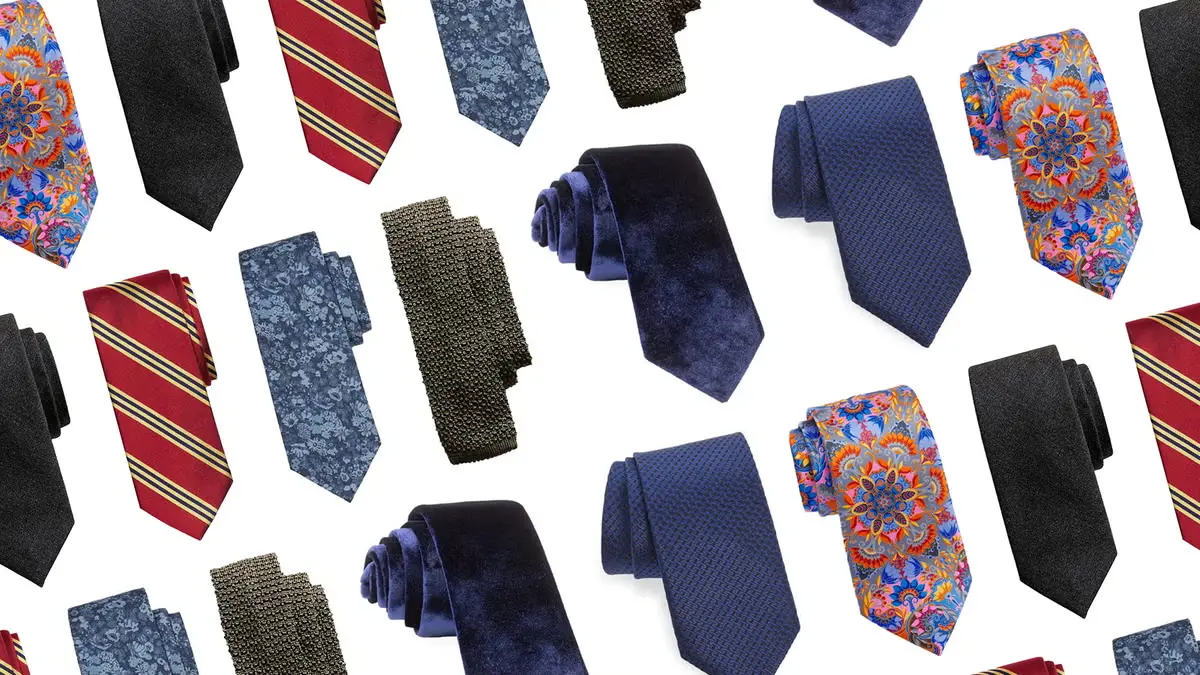Not all ties are created equal. From sleek silk classics to laid-back knits, men’s ties come in all types of styles, fabrics, and patterns—and each one says something different about your look. Want to appear sharp and professional? Reach for a solid silk tie. Aiming for something a little more relaxed or trendy? Try a knitted or patterned tie to mix things up.
In this guide, we’ll walk through the most popular types of men’s ties, break down the key fabrics they’re made from, and show you the most common tie patterns you’ll see—from stripes and polka dots to paisley and more. You’ll also get simple tips on when to wear each style, how to pair them with shirts and suits, and what works best for different occasions.
This is your no-fuss guide to understanding men’s ties. We’ll help you pick the right style, fabric, and pattern for any outfit or occasion—so you can look sharp, feel confident, and get the most out of every tie in your collection.
Tie Styles
Necktie (Standard)
We’ll start with the Necktie. The classic necktie is the go-to choice for most men. It’s that familiar long strip of fabric worn under the shirt collar and tied at the throat. Simple, timeless, and incredibly versatile, the standard necktie works for everything from job interviews to weddings and everyday office wear.
Neckties come in a wide range of widths, fabrics, and colors, so there’s something to match every style and occasion. You can switch up the look by using different tie knots like the Windsor, half-Windsor, or four-in-hand. For a sharper, more modern appearance, skinny ties are a popular pick—while wide ties offer a retro, bold vibe inspired by the 1970s.
Materials like silk, polyester blends, or woven fabrics give neckties their polished finish, making them ideal for business settings, formal events, and daily professional wear. When in doubt, a well-fitted tie in a solid color or subtle pattern is a safe, stylish choice.
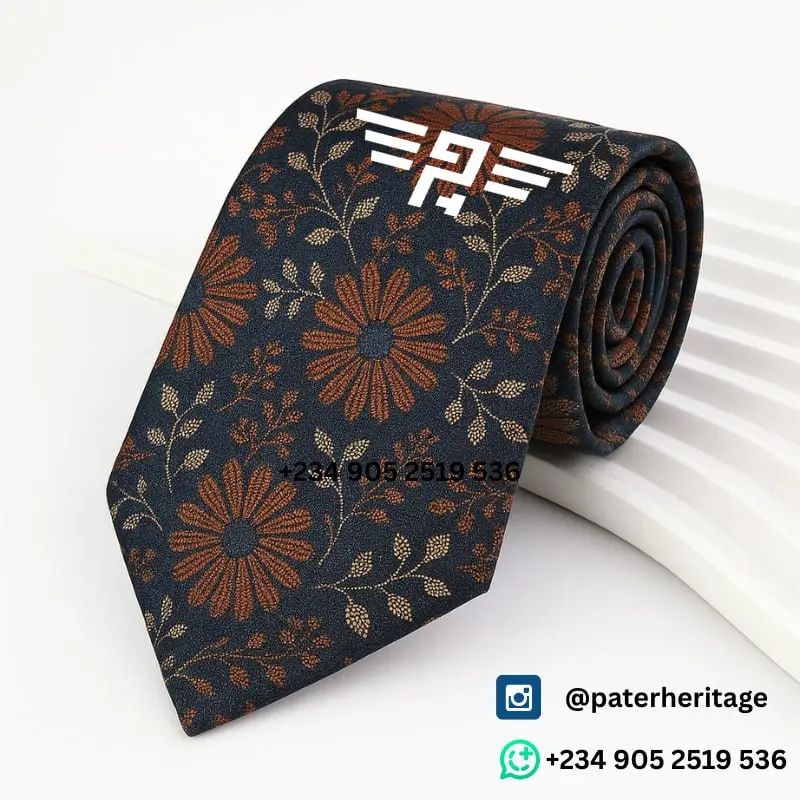
You can learn how to knot a necktie here
Bow Tie
The bow tie is a timeless classic—shaped like a ribbon bow and worn around the collar. It’s the signature accessory for formalwear, especially at black-tie events, where it’s typically paired with a tuxedo. A well-chosen bow tie adds instant polish and is a staple for weddings, galas, and other formal evening occasions.
Bow ties come in two main styles: the self-tie, which you tie yourself for a traditional look, and the pre-tied version, which clips on for convenience. While often seen in sleek black or deep silk tones for formal events, bow ties can also be playful and expressive. Colorful or patterned versions are popular at cocktail parties, semi-formal events, or in more casual style settings.
In the U.S. South, bow ties are often worn with seersucker suits during the summer—blending tradition with personality. Whether you’re dressing up for a black-tie affair or looking to stand out at a social gathering, the bow tie offers a smart, stylish alternative to the standard necktie.
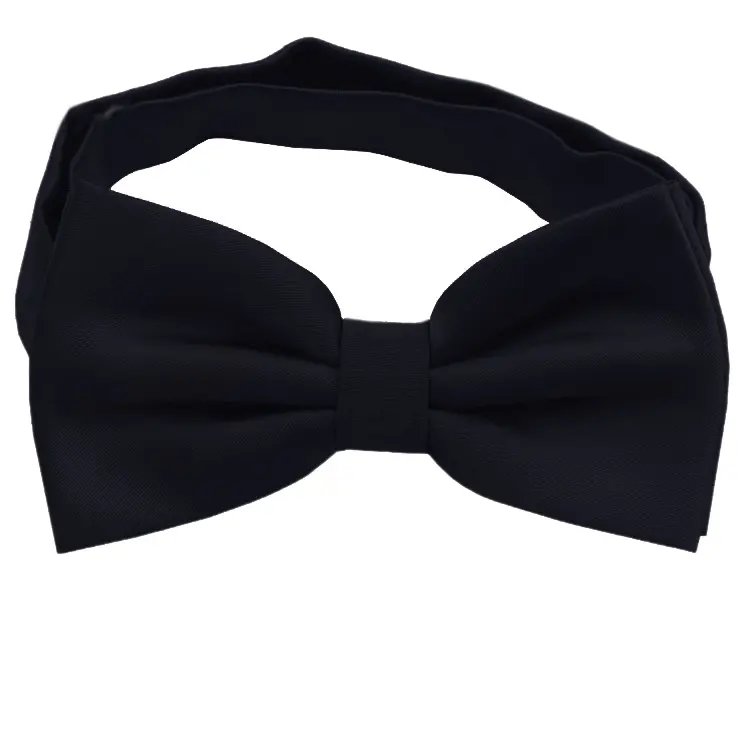
Bolo Tie
The bolo tie, also known as a Western necktie or cowboy tie, is a unique style that features a braided leather cord with metal tips and a decorative sliding clasp. Originally invented in Arizona in the mid-1900s, it quickly became a symbol of Southwestern fashion and is now the official state neckwear of Arizona, New Mexico, and Texas.
Wearing a bolo tie is simple: drape the cord around your neck and slide the clasp up near the collar—either snug for a formal Western look or loose for a more relaxed feel. Bolo ties are most commonly worn with Western shirts, cowboy boots, and bolo jackets or vests, and they bring a rugged, casual flair to any outfit.
Popular at country weddings, rodeo events, Western-themed parties, and in everyday wear throughout the Southwest, bolo ties are a go-to accessory for those embracing Western-inspired men’s fashion. While they experienced a brief revival in the 1980s and remain a bold statement accessory today, they’re typically too casual for traditional business settings outside of Western regions.
For those searching for a stylish alternative to a necktie, the bolo tie adds personality, history, and a regional touch that stands out from the crowd.
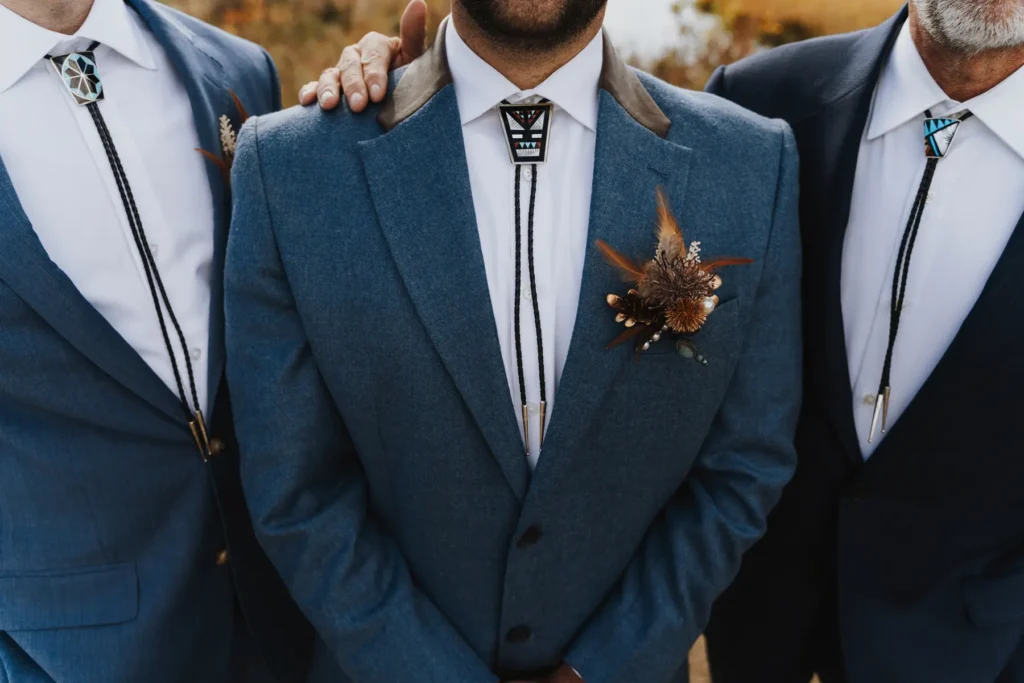
How to Wear a Bolo Tie Step by Step
Here’s a simple step-by-step guide on how to wear a bolo tie:
- Choose the Right Shirt
Start with a collared shirt—preferably a button-down. Western-style shirts work well for casual looks, while a crisp dress shirt is better for formal or semi-formal outfits. - Place the Bolo Around Your Neck
Drape the cord evenly around the back of your neck so that both ends hang down the front of your chest. - Adjust the Slide
Slide the decorative clasp or ornament up toward your neck.
- For a formal or polished look, position the slide snugly at the top button of your shirt (which should be buttoned).
- For a casual or relaxed style, let the slide sit lower—around mid-chest level.
- For a formal or polished look, position the slide snugly at the top button of your shirt (which should be buttoned).
- Secure the Fit
Most bolo ties stay in place with light tension. If needed, gently tug the cords to tighten the slide, making sure it’s centered.
Ascot
The ascot tie, also known as a formal cravat or dress ascot, is a wide neckband with pointed ends, traditionally made from silk. It’s worn by crossing the ends over each other and securing them with a decorative pin, tie tack, or by tucking them neatly into the shirt. Known for its classic and aristocratic look, the ascot adds a refined touch to formal daytime attire for men.
The name comes from the prestigious Royal Ascot horse race in England, where this elegant neckwear rose to prominence among well-dressed gentlemen during the 19th century. Today, there are two primary styles of ascot ties, each suited to different occasions:
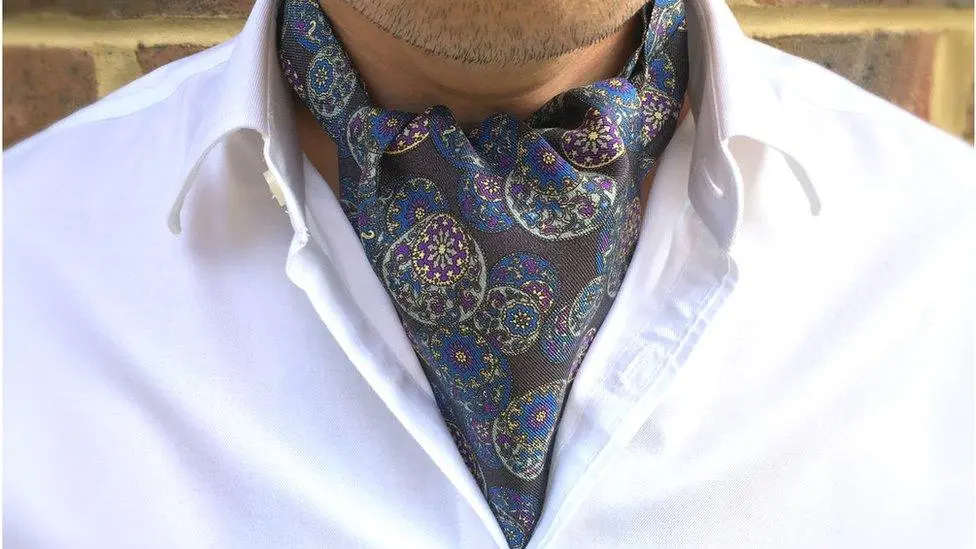
Formal Ascot (or Plastron)
Typically made from silver or gray silk, the formal ascot tie is worn with a traditional morning coat and is a staple for daytime weddings, formal garden parties, and British high-society events like Royal Ascot. This version of the ascot is ideal for those seeking a sophisticated alternative to a necktie at formal occasions.
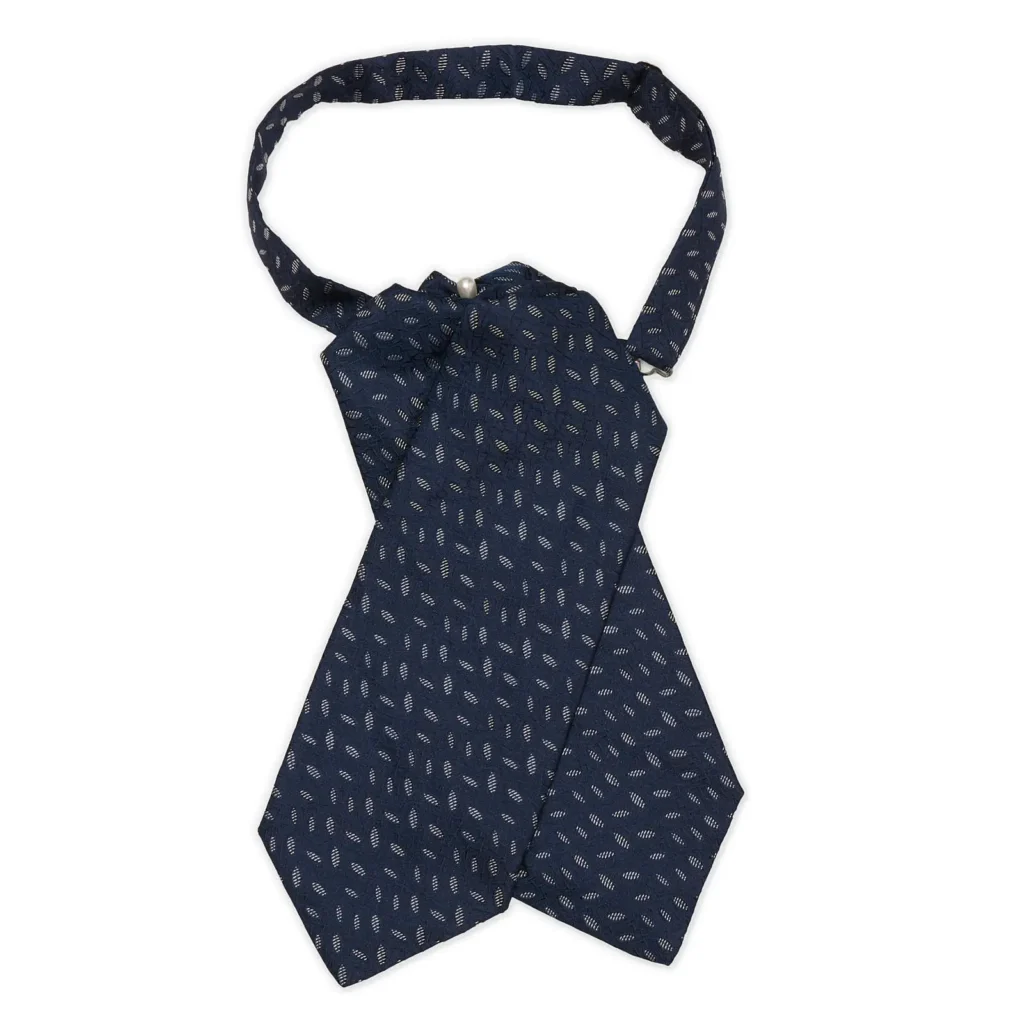
Day Ascot (Informal Cravat)
The day ascot, also referred to as an informal cravat, is a softer, scarf-like variation often crafted from patterned or solid-colored silk. Worn under an open shirt collar, it’s perfect for adding a vintage-inspired touch to smart casual outfits for men. A paisley day ascot paired with a blazer or sports coat instantly elevates a look with subtle, old-world charm.
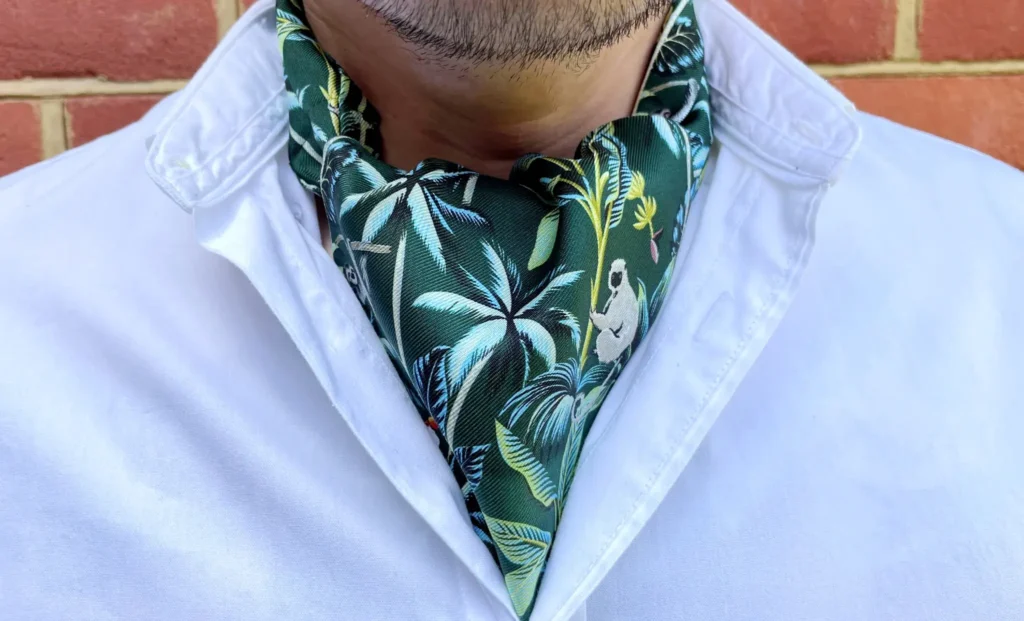
How to Wear an Ascot Tie
Wearing an ascot tie properly depends on the formality of the occasion and the style of ascot you choose:
For Formal Events:
- Start with a dress shirt with a stiff collar, usually wingtip or spread.
- Drape the ascot around your neck, letting the ends hang evenly.
- Cross the ends over one another, similar to tying a scarf.
- Pin the ascot in place with a cravat pin or tie tack, or tuck it neatly into your shirt for a clean, secure look.
- Pair it with a morning coat or a formal suit for an elegant, regal impression.
For Casual or Smart Casual Looks:
- Choose a soft day cravat in silk or cotton—paisley or solid colors work best.
- Wear it under an open shirt collar, not buttoned up.
- Tie it loosely in a simple knot or fold, allowing the fabric to drape naturally.
- Complement the look with a blazer, cardigan, or sports jacket for a polished but relaxed appearance.
Cravat
The cravat is the original neckwear—the ancestor of both the modern necktie and bow tie. At its core, a cravat is any decorative cloth tied around the neck. While its history dates back to the 17th century, today the term generally refers to a silk day cravat—a relaxed, scarf-like tie worn under an open shirt collar for a touch of vintage elegance.
In British fashion, “cravat” is often used to describe this informal style: a patterned silk scarf worn loosely beneath a collared shirt. This version is also known as a day cravat, and it’s closely related to the casual ascot. While the formal ascot tie is used for weddings and worn with a pin and morning coat, the day cravat is more about everyday sophistication.
Historically, cravats were long strips of cloth—sometimes lace or fine linen—wrapped and tied in elaborate styles. This look evolved into the more structured ascots and neckties we see today.
Wearing a cravat now is about making a statement. It’s rarely seen in everyday office wear but can be the perfect choice for:
- Victorian-themed events
- vintage weddings
- formal morning dress
- or simply adding a bit of old-world charm to a weekend outfit.
For a groom, a silver cravat or formal ascot is a classic choice for a daytime ceremony. For fashion enthusiasts, a paisley or polka dot day cravat under a blazer brings personality and period flair without going over the top.
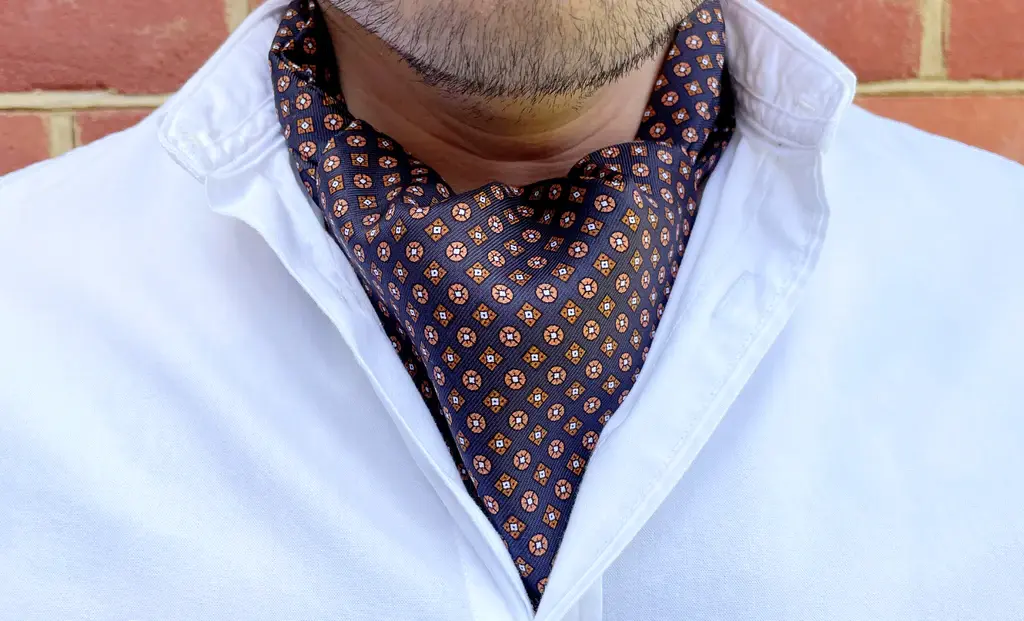
Tie Fabrics and Materials
The fabric of a tie plays a huge role in how it looks, feels, and when it should be worn. Different materials affect not only the texture and drape but also the level of formality and seasonality. From high-end silk to casual cotton and cozy wool, choosing the right tie fabric can elevate your outfit for the right setting and time of year.
Silk ties
Silk ties are the most popular and widely worn. Known for their smooth texture and elegant sheen, a quality silk tie drapes cleanly and instantly adds a polished look. Most formal silk ties for business suits and classic bow ties for tuxedos are made from pure silk or silk blends. These are the go-to choice for job interviews, boardroom meetings, weddings, and any occasion where professionalism is key.
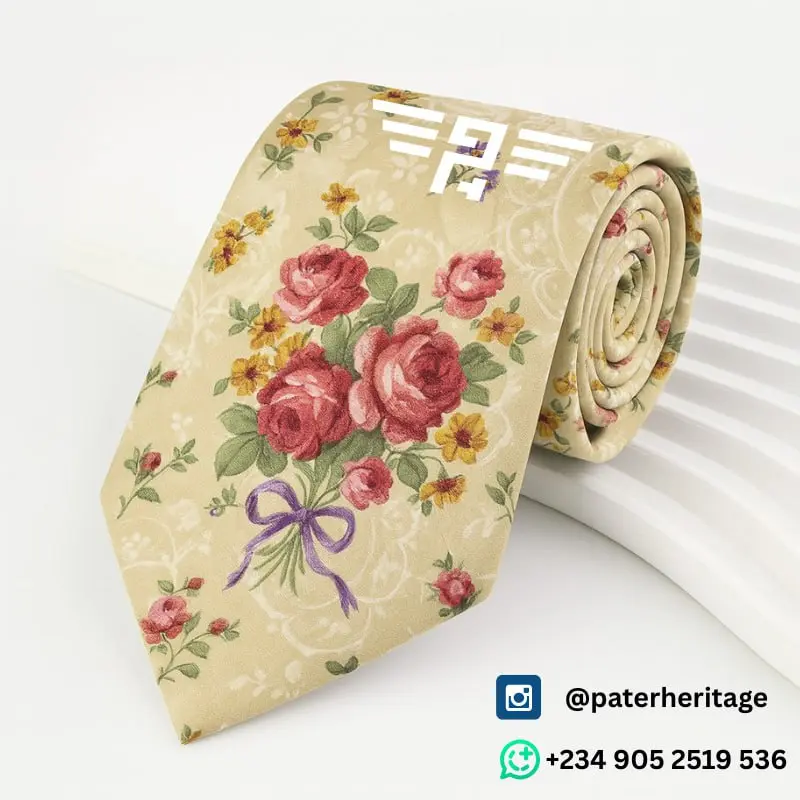
Cotton ties
Cotton ties offer a softer, more relaxed vibe. As a lightweight tie for summer, cotton is breathable and ideal for warmer weather or more casual events. These ties often come in floral or paisley prints and are a great choice for pairing with linen shirts, khakis, or casual suits in spring or summer. A cotton floral tie, for example, looks right at home at an outdoor garden wedding or a brunch date.
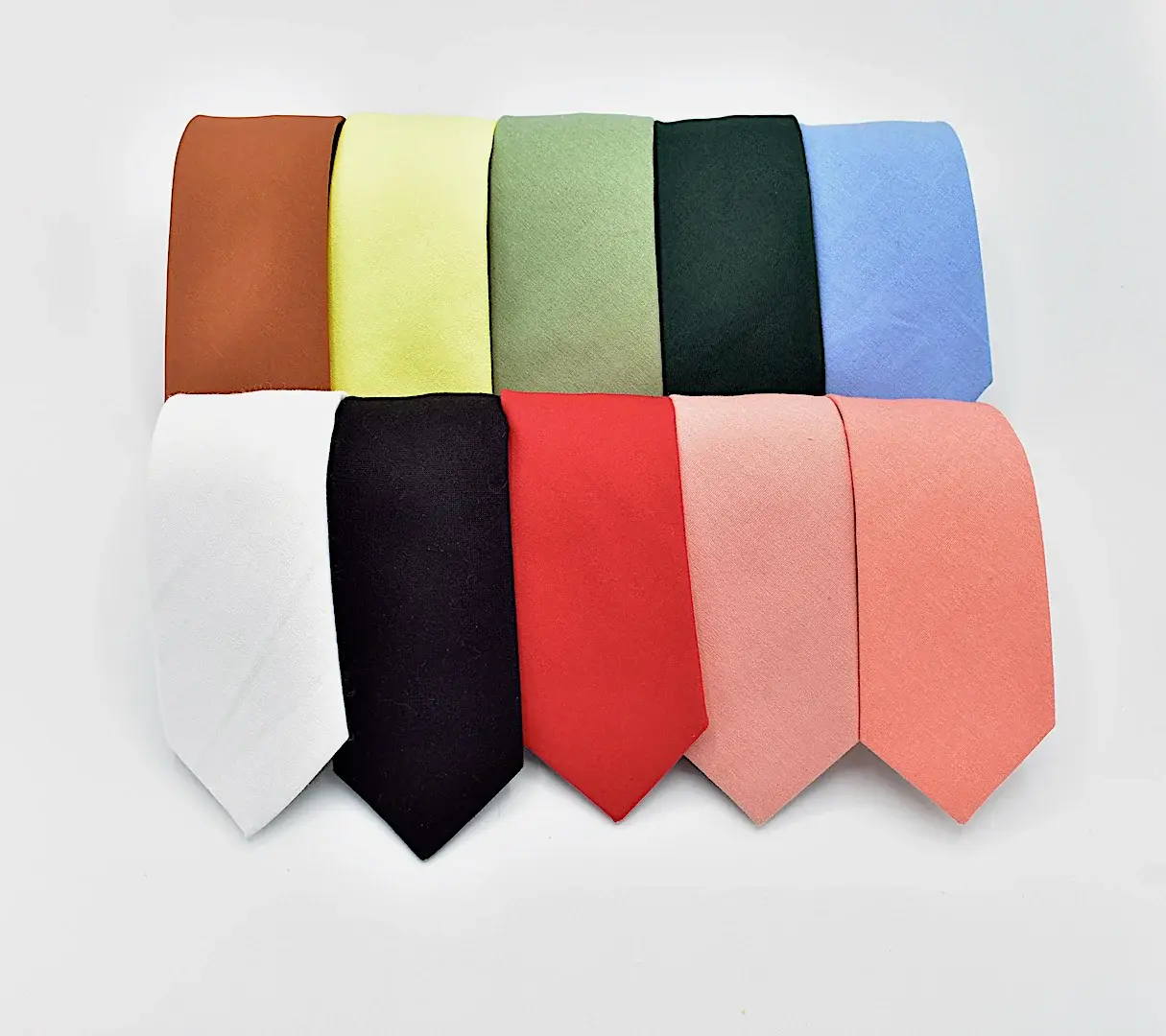
Linen ties
Linen ties are similar to cotton in their breathability but have a slightly rougher texture and a matte finish. Choosing a linen tie for a summer wedding or daytime event gives off a cool, effortless style. These ties wrinkle easily, which adds to their laid-back charm. A light linen necktie pairs well with seersucker suits or light-colored blazers, perfect for beach weddings or relaxed formal settings.
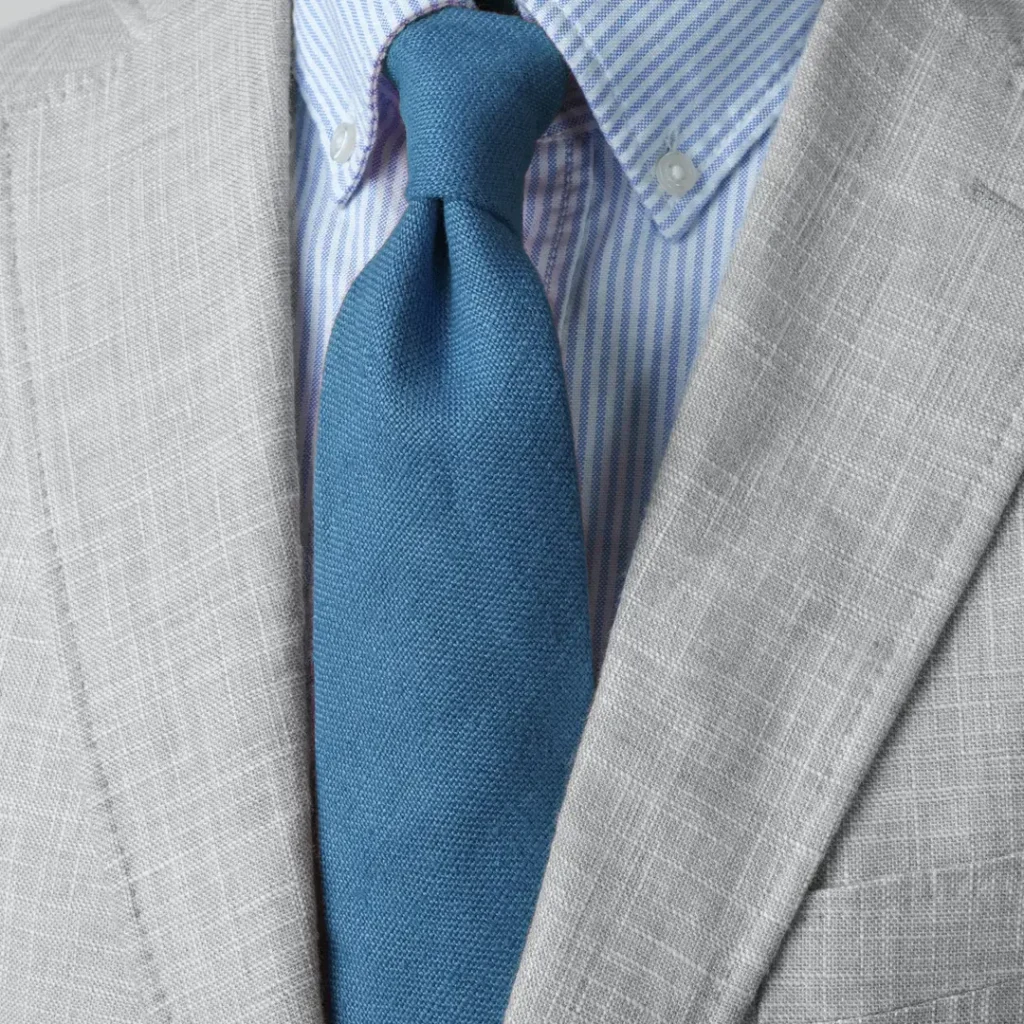
Wool ties
Wool ties, on the other hand, are best suited for colder months. A wool tie for winter outfits provides extra texture and warmth, making it ideal for layering with heavier suits or tweed blazers. Whether it’s worsted wool, flannel, or a rich tweed fabric, wool ties are a staple of autumn and winter wardrobes. Wearing a tweed necktie with a wool suit adds a touch of classic, academic style, especially in colder climates.
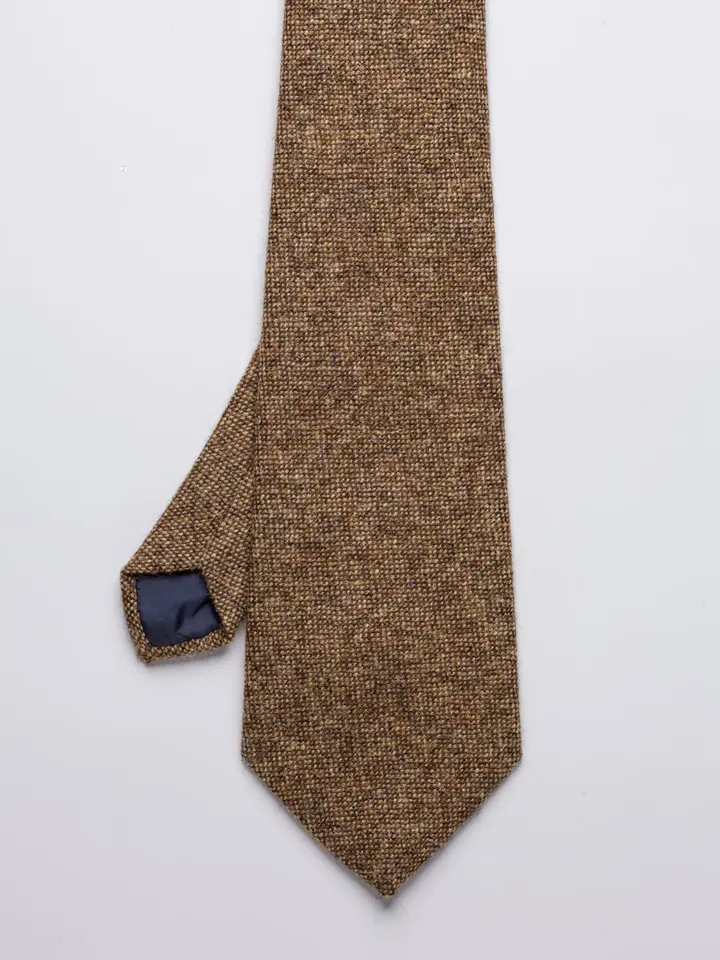
Polyester and microfiber ties
Polyester and microfiber ties are the practical workhorses of the tie world. Often chosen for their durability and low cost, these ties mimic the look of silk but have a slightly stiffer feel. A washable polyester tie for men is perfect for everyday office wear, uniforms, or situations where convenience matters more than luxury. Though they may lack the rich texture of silk, they come in a wide variety of prints and are easy to maintain.
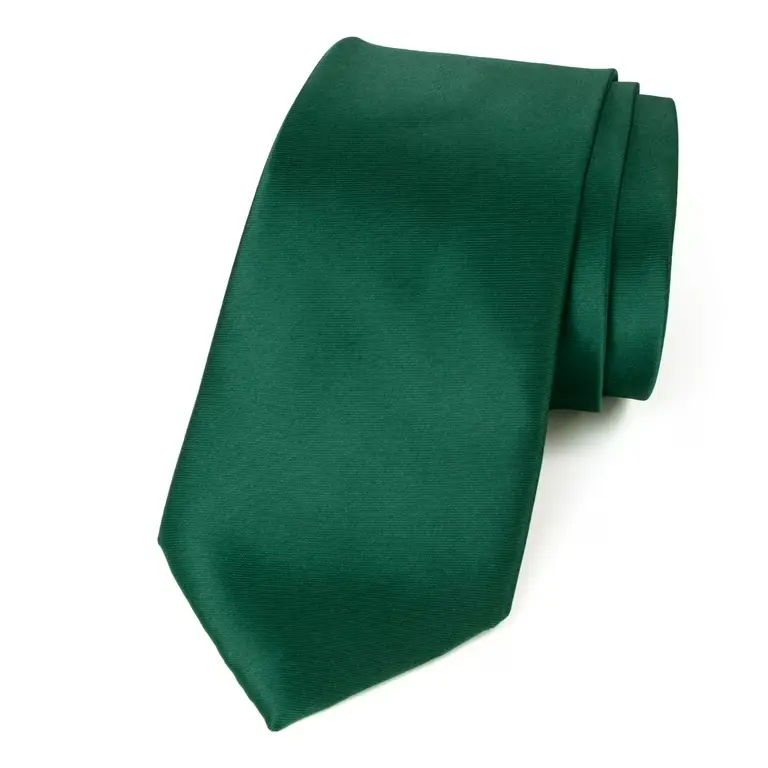
Knit ties
Finally, knit ties offer a different texture altogether. These ties are usually made from silk or wool yarn and have an open, knitted weave with a flat bottom. A navy knitted tie for smart casual outfits pairs perfectly with an Oxford shirt and cardigan, making it a favorite in preppy or Ivy League style. While knit ties are less formal than traditional silk, they’re incredibly versatile and work well for both business-casual and relaxed dress codes.
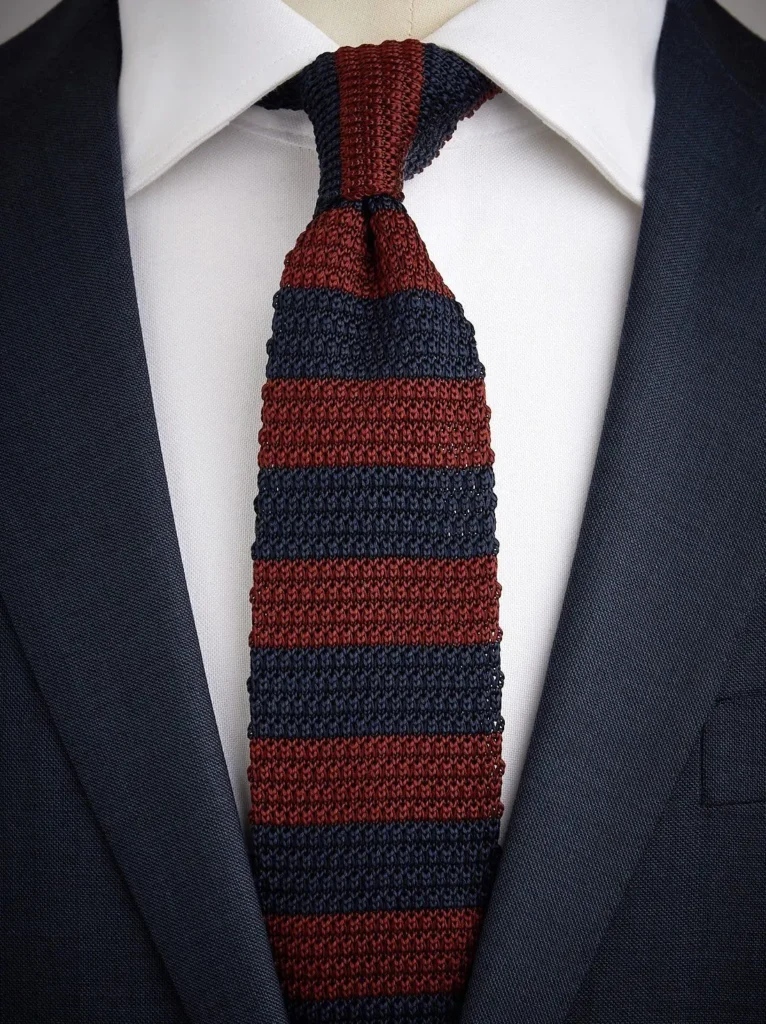
Common Tie Patterns
Ties are also distinguished by their patterns (or lack thereof). Certain patterns are classics in men’s neckwear, each lending a different character to an outfit:
- Striped: Striped ties feature diagonal or horizontal bands of color. They are a timeless choice for business and collegiate style – for instance, British “regimental” stripes originally denoted military or club affiliations. Today, striped ties (from simple two-color stripes to multi-color university ties) convey a smart, professional look. They can show school or team colors, or just add a bold accent to a suit. (In the U.K., regimental stripes typically run from top left to bottom right, while American stripe ties often reverse the direction. A navy tie with thin white stripes, for example, is excellent for office wear or interviews, whereas a brightly colored stripe might be more casual or fashion-forward.
- Paisley: Paisley ties feature an ornamental swirled teardrop motif of Persian/Indian origin. This intricate pattern has a long history in menswear and is associated with a refined, somewhat flamboyant style. Paisley silk ties became popular for their timeless elegance and are often worn for business, weddings, or other dressed-up occasions. A classic paisley tie (say, burgundy with blue and gold paisleys) adds personality while still looking distinguished. Paisleys can range from large and bold to small, subtle designs, allowing them to be either the standout piece of an outfit or a complementary pattern.
- Polka Dot: Dotted ties (polka dot ties) have a field of repeating dots and can range from playful to polished. The formality often depends on the size and spacing of the dots. Small, subtle dots on a dark solid background can appear quite elegant – suitable even for business or formal wear – whereas larger or multicolored dots tend to look more whimsical and casual (Rule of thumb: the smaller and more spaced the dots, the more formal the impression. For example, a navy tie with tiny white pin-dots pairs well with a suit for a meeting, while a tie with big bold polka dots might be best for a fun party or festive event.
- Plaid / Check: Plaid ties (including checks and tartans) display crisscrossing stripes of varying colors, forming squares or tartan patterns. Rich in tradition, plaids originated from Scottish clan tartans and bring a bit of heritage to an outfit. Today, plaid ties come in many color combinations and scales – from subtle glen checks to bold madras or tartan. A dark plaid in muted tones can be office-appropriate and add texture to a plain suit, whereas a bright tartan might be worn around the holidays or for a statement look. Plaid ties are quite versatile: pair a fine black-and-gray check tie with a charcoal suit for a business look, or try a larger buffalo plaid tie with a tweed jacket for a fall ensemble. They carry a slightly less formal, more approachable vibe than solid or regimentally striped ties, yet remain a classic choice.
- Solid: Solid color ties (with no pattern) are arguably the most versatile. A single-color tie in a silk or similar fabric is easy to coordinate with patterned shirts or suits. For a conservative look, men often choose solid neutrals like navy, charcoal gray, or burgundy – which are appropriate for nearly any occasion. Solid ties can also be bold (e.g., a bright red power tie or a crisp white tie for black-tie dress codes). The finish of the fabric makes a difference: a solid satin-silk tie has a lustrous sheen suited for formalwear or evening events, while a solid knit or wool tie in matte finish appears more casual. Every wardrobe should have a few solid ties, since they’re “safe” options that still can be very elegant (for example, a solid black silk tie is a staple for funerals or can accompany a tuxedo in some modern black-tie interpretations).
- Novelty: Novelty ties are ties with non-traditional, playful images or themes – think ties decorated with holiday motifs, cartoon characters, hobbies, or any fun print. These ties are a way to show personality or celebrate an occasion. They are not typically worn in formal or professional settings, but rather on special casual days or as gag/statement pieces. For instance, one might wear a Christmas-themed tie to a holiday party or a tie with golf illustrations to a casual Friday if it fits one’s interests. Novelty ties make popular gifts (e.g. a teacher getting an apple-print tie, or a Dad getting a tie with his favorite sports team). While they aren’t part of a classic elegant wardrobe, they have their place: use them to add humor or festivity, but avoid wearing them to conservative business meetings or formal events.
Conclusion
Ties may seem like small accessories, but they carry a big impact. From the classic silk necktie to the bold bolo tie or the vintage-inspired day cravat, every tie has its own character—and the right one can elevate your entire look. By choosing the appropriate tie fabric, style, and pattern, you can dress confidently for any occasion.
A formal silk tie for business suits or a black bow tie for tuxedos fits perfectly at weddings, galas, and high-stakes meetings. On the other hand, a casual knit tie for smart outfits or a linen tie for summer weddings adds charm and individuality in more relaxed settings. Even a colorful cotton tie for daytime events or a Western bolo tie for country weddings can become a signature piece when styled thoughtfully.
Ultimately, understanding the different types of men’s ties, from materials to styling cues, allows you to build a versatile wardrobe that works across all seasons and dress codes. Whether you’re heading to a boardroom or a barn dance, there’s always a perfect tie to match your style, the season, and the moment.

